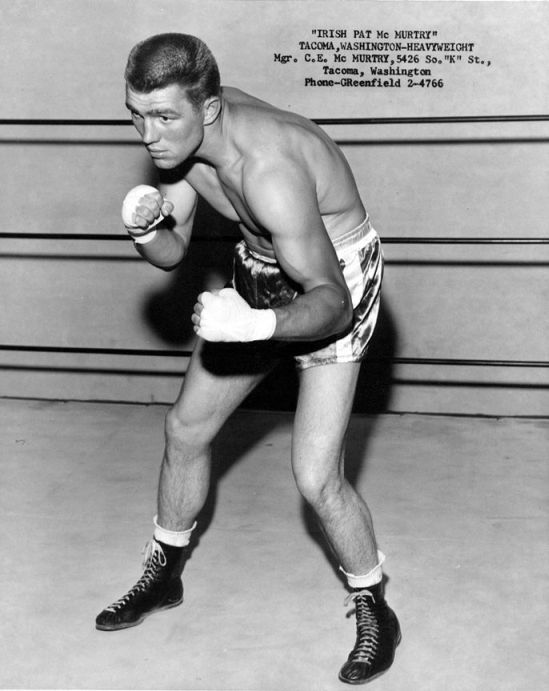PAT McMURTRY: THE FIGHTING LEATHERNECK
By Austin Killeen
(Published in IBRO Journal 104, December 2009)
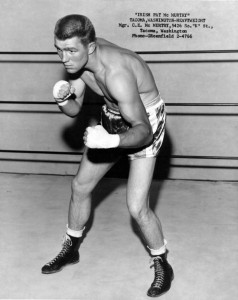 Latin for “always faithful,” Semper Fidelis became the Marine Corps motto in 1883. It guides the Marine to be faithful to the mission at hand. If you’ve ever had the pleasure to witness Pat McMurtry in action, then you know he always displayed the meaning of Semper Fi in his pugilistic career. Both amateur and professional, the mission for the Tacoma native was victory and no amount of adversity could sway him from that goal.
Latin for “always faithful,” Semper Fidelis became the Marine Corps motto in 1883. It guides the Marine to be faithful to the mission at hand. If you’ve ever had the pleasure to witness Pat McMurtry in action, then you know he always displayed the meaning of Semper Fi in his pugilistic career. Both amateur and professional, the mission for the Tacoma native was victory and no amount of adversity could sway him from that goal.
Pat got his introduction to boxing, along with his younger brother Michael, on Christmas day in 1939. Their father Clarence, a former amateur boxer, gave them boxing gloves for a present. Like ducks taking to water, the brothers’ McMurtry, took a liking to the pugilistic trade. “Each year dad would take Mike and me to the finals of the Golden Gloves in Seattle, Washington. We would stay at the Hunger Fort Hotel and eat at Ben Paris’s sports bar.” Eventually, Mr. McMurtry took his boys to Homer Amundsen’s gym in Tacoma, Washington. The Tacoma Star Light Athletic Club would be the location where the McMurtry boys would acquire their fistic schooling.
Pat was immediately impressed watching the pros working out; snorting, sweating, boxing and hitting the speed bag. Among the experienced fighters present were Paulie Cooke (FW) and Jess Hall (HW) both in the punch for pay ranks and amateur Vergil Larson, who would become an outstanding boxer at Gonzaga University. Pat said this was a great experience for a sixteen year old getting his feet wet in the sport. Before Amundsen would allow Pat to spar with the above named pros, he had to learn the fundamentals of the game.
Pat spent months standing in front of a mirror with a hand towel tucked under his right arm pit, throwing left jabs. If the towel hit the floor, Homer knew McMurtry was moving his right when throwing his left jab. This was a dangerous bad habit that a good counter puncher would quickly exploit in the ring. Slowly Amundsen exposed his young prospect to jumping rope, and the use of the heavy and speed bags. It was only after months of non contact drills that Pat was allowed to spar with other fighters in the gym. McMurtry was quick to appreciate the months spent throwing his jab in front of a mirror; as the punch could serve as both an offensive and defensive weapon. McMurtry also would have the opportunity to work with LHW Champ Joey Maxim, and top heavyweight Roscoe Toles. Commenting on Maxim, Pat said “Maxim was a wonderful person, who gave me much encouragement and advice when we sparred and did roadwork.”
After working in Homer’s gym for approximately seven months, Amundsen said “I think you’re ready. I’m entering you in the Golden Gloves in Portland, Oregon.” “This was in 1949 and I won three fights, two by knockout. So I won the tournament in the middleweight division, as that’s what I fought at during that time.” It wasn’t long before both brothers started making a name in the Pacific Northwest, in amateur competition. “My brother Mike was 14 months younger than me, but followed in my footsteps the following year. We won golden gloves, AAU and diamond belts titles in Oregon, Washington and Western Canada over the next four years. Additionally, boxing made it possible for both of us to attend Gonzaga University where we won titles at the collegiate level.”
One of Pats two losses took place at the National AAU tournament in Boston in 1951. While winning his first two bouts by knockout, McMurtry broke a bone in his right hand. He elected to box on, losing a close decision to eventual winner Jack Boutilier in the semi-finals. Pat received the first sportsmanship award in the 63 year history of the tournament, for his courageous efforts. “By the time we finished our amateur careers I had 129 bouts losing only two and Mike had 7 loses in 172 fights.” {Mike had one pro fight, which he won, and retired.}
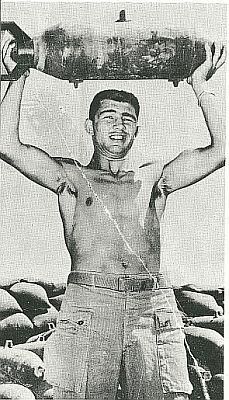 “Homer wanted me to turn pro when I was twenty one but the Korean Conflict broke out and I joined the Marines instead.” Pat was sent to Korea, where he would be stationed for 4 years. He quickly rose through the ranks, ultimately achieving the rank of staff sergeant. He saw a great deal of combat, earning three battle stars as a result of combat action. When not engaging the North Koreans, Pat was a member of the Marine boxing team. He won the All Marine and the Far East Tournaments, never losing a fight as a leatherneck. McMurtry gained further recognition when a war correspondent for the New York News took his picture. Sergeant McMurtry was holding a one hundred pound bomb over his head; which the paper used for its Sunday cover layout. With the biggest circulation in the country, Pat’s photo was seen coast to coast. When his tour of duty was up, he was offered the opportunity to attend Officers Candidate School; being commissioned a Second Lieutenant at the completion of the program. Pat politely declined as his immediate goal was to return state side and turn pro.
“Homer wanted me to turn pro when I was twenty one but the Korean Conflict broke out and I joined the Marines instead.” Pat was sent to Korea, where he would be stationed for 4 years. He quickly rose through the ranks, ultimately achieving the rank of staff sergeant. He saw a great deal of combat, earning three battle stars as a result of combat action. When not engaging the North Koreans, Pat was a member of the Marine boxing team. He won the All Marine and the Far East Tournaments, never losing a fight as a leatherneck. McMurtry gained further recognition when a war correspondent for the New York News took his picture. Sergeant McMurtry was holding a one hundred pound bomb over his head; which the paper used for its Sunday cover layout. With the biggest circulation in the country, Pat’s photo was seen coast to coast. When his tour of duty was up, he was offered the opportunity to attend Officers Candidate School; being commissioned a Second Lieutenant at the completion of the program. Pat politely declined as his immediate goal was to return state side and turn pro.
Discharged from the Marine Core, the Tacoma Tiger finally turned pro at the age of 24. Well schooled as a result of his extensive amateur experience and having the opportunity to spar with some excellent pros at the Star Light Athletic Club, Pat’s entrance into professional boxing went smoothly. He was quickly 4 and 0 all by knockout in the first two months of his career. In his next bout Pat stepped up in class, scoring a point’s win over previously undefeated Max Chris in Seattle. He followed up with four more wins, all of which ended early. Fighting at the Tacoma Armory in his next fight, Pat had some surprisingly difficult competition. His opponent Chuck Ross who resembled Tony Galento apparently had not read McMurtry’s scrap book. With a 24 pound weight advantage, Ross fought hard until being stopped because of a deep cut over his left eye. Clearly McMurtry was meeting better competition, competition which was needed if he was to move up to the next level on the boxing food chain. Ring magazine was impressed by the Tacoma natives start to his pro career and Pat was selected as Ring Magazine prospect of the month in October 1954.
Gene Brixen, a solid club fighter was next up. Prior to the bout, Brixen said; “I hate to see McMurtry get a loss.” Pat commented, “I knew he’d feel bad if it ended that way, so I stopped him in two.” Wins over granite chinned Chuck Woodworth and German veteran Hans Friedrich added to Pat’s quickly growing reputation in the fistic community. Freedrich’s manager Baron von Stumme was very impressed with the local boy’s poise. “He’s like a big cat,” von Stumme said. “One punch did it – the right hand when he had Hans against the ropes.” Outclassed Murray Burnett and a difficult win over J.D. Reed followed. “Reed was very good and gave me six tough rounds before being stopped.”
Big Bob Albright out of San Fernando, California was next for the Tacoma Tiger in Seattle. Like Pat, Albright was considered a hot prospect and figured to be a difficult test. Pat sighed and said; “I don’t want to call him a dirty fighter, who butted, let’s just say he pushed the rules a little bit.” Pat used cat like reflexes and lateral movement to offset Albright’s 28 pound weight advantage. After eight brutal and bloody rounds the ring officials declared the match a draw. McMurtry injured his right hand in the third round and was taken to the hospital after the fight. X-rays showed a bone injury in the right hand which put Tacoma’s leading export on the shelf for six months.
Recovered from his hand injury, Pat ran off four in a row all by stoppage. This included Bob Dunlap and Cordell Jones a pair of cagey veterans who had fought some of the best fighters in the division. Although post prime, both men were still capable of exposing an overhyped nothing. Clearly McMurtry was much better than that. This lead to the biggest match of the Tacoma native’s career to date. Former heavyweight champ Ezzard Charles would be next on the menu.
Although post prime, Charles had just stopped old McMurtry foe Bob Albright in his last fight. If there was any doubt that Tacoma area fight fans were excited about this matchup, it was answered when over 13,000 spectators filled the Lincoln bowl that evening. McMurtry, appearing over-trained at 182 pounds to Charles’ 197 was “tight” through the early rounds. Pat scored with a left jab, but used his right sparingly. A tight defense and good lateral movement helped the local boy fend off the Cincinnati Cobra’s attack.
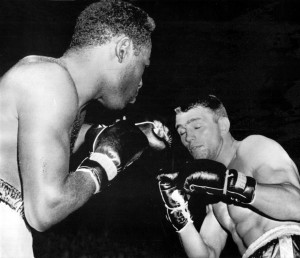 Watching the video, it appeared that Ezzard was starting to break through McMurtry’s defense in the middle rounds. Trapping Pat on the ropes, the ex champ seemed to land many telling shots to the body. In the seventh Charles landed a right to the belt line; Referee Davey Ward ruled the blow was low and allowed McMurtry a two-minute rest. The interruption didn’t help Pat, as Charles continued to pound the Tacoma Tiger in the eighth. In the final two rounds McMurtry finally seemed to unwind, following up his jab with overhand rights and left hooks. The home town boy was the recipient of a unanimous verdict.
Watching the video, it appeared that Ezzard was starting to break through McMurtry’s defense in the middle rounds. Trapping Pat on the ropes, the ex champ seemed to land many telling shots to the body. In the seventh Charles landed a right to the belt line; Referee Davey Ward ruled the blow was low and allowed McMurtry a two-minute rest. The interruption didn’t help Pat, as Charles continued to pound the Tacoma Tiger in the eighth. In the final two rounds McMurtry finally seemed to unwind, following up his jab with overhand rights and left hooks. The home town boy was the recipient of a unanimous verdict.
In his post fight interview, Charles felt the referee’s actions deprived him of a knockout. There’s no question that McMurtry was hurt, as he turned to his side in pain and leaned on the ropes. Unfortunately it was impossible to tell where the punch in question landed, as Pat’s body blocked the camera’s view. Watching the bout several times, it appeared the fight was much closer than the score cards had it. Commenting on the fight, Pat stated; “Charles was not a dirty fighter he unintentionally landed a low blow.” One fact was unmistakable, even at the end of his career; Charles had incredible skills both on the attack and defensively. It doesn’t take much imagination to see why many experts feel Charles is the best light heavyweight in the history of boxing. Pat and Ezzard remained close friends until the day the former champ passed away.
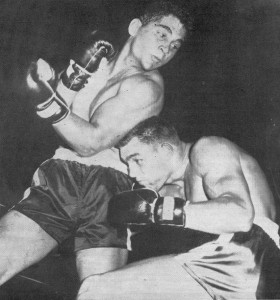 Returning to the Lincoln bowl the following month, McMurtry met leading heavyweight contender Willie Pastrano before a crowd of over 11,000 spectators. Surprisingly Pat entered the ring at 178 pounds, the lightest of his career. This was part of his fight plan, hoping the lighter weight would increase his speed against the New Orleans cutie. In the opening round Pastrano took away McMurtry’s jab with his lightning footwork. Having no fear of the visitors punching power, the Tacoma lad just worked inside with surprising success. In both the second and seventh rounds McMurtry rocked Pastrano with solid left hooks, but was unable to capitalize on these opportunities.
Returning to the Lincoln bowl the following month, McMurtry met leading heavyweight contender Willie Pastrano before a crowd of over 11,000 spectators. Surprisingly Pat entered the ring at 178 pounds, the lightest of his career. This was part of his fight plan, hoping the lighter weight would increase his speed against the New Orleans cutie. In the opening round Pastrano took away McMurtry’s jab with his lightning footwork. Having no fear of the visitors punching power, the Tacoma lad just worked inside with surprising success. In both the second and seventh rounds McMurtry rocked Pastrano with solid left hooks, but was unable to capitalize on these opportunities.
The fight was very close and watching the video neither boxer seemed to gain a clear advantage. Considering the fight was in McMurtry’s home town, it was surprising he lost a unanimous decision. Pat said after the fight Angelo Dundee, Willie’s trainer entered his dressing room. “What’s the matter kid, don’t they like you in this town. We would have been happy to get out of here with a draw.” A letter Dundee wrote to the local press years later when he brought Luis Rodriguez to Washington State to fight, gives credence to McMurtry’s story. Regardless of the fight’s outcome, there’s no question the experience of fighting Charles and Pastrano made the Tacoma boy a more polished fighter.
Pat traveled to Portland, Oregon in December of ‘56’ stopping tough journeyman Joey Rowan after seven difficult rounds. Returning to the sometimes friendly confines of Tacoma, Washington, Pat faced hard punching Reuben Vargas. With several overhand rights and a strong body attack, Vargas appeared to capture the first two rounds. With half a minute gone in the third, McMurtry exploded a short left hook on Vargas’ chin dropping the Californian for the first time in his career. Rising on unsteady legs, Vargas was dropped again by a volley of Pat’s punches. Rising once more, the defenseless Vargas was saved from further punishment by referee, Whitey Domstad.
Irish Pat McMurtry continued his winning ways with a unanimous decision over Edgardo Romero in Seattle. Giving away 62 pounds to the hulking Argentinean giant, Pat scored with punishing combinations over the final four rounds to gain the verdict. Traveling to San Francisco in June, Pat captured a unanimous 10 round decision over veteran Howard King of Reno, Nevada. The Tacoma native controlled the action with a flicking left jab but was unable to hurt the more experienced King at any time during the fight. As a result of Pat’s success, Ring magazine ranked him for the first time in August ‘57’ at # 10.
Returning to Portland in August, Pat met former middleweight champ Bobo Olson. “I was real nervous about this bout because Olson was a real good body puncher on the inside and knew how to use his head.” Apparently McMurtry’s fears were justified, as Olson won the first round in the eyes of most ringsider’s with a strong body attack. A slow starter, McMurtry began to find the range with combinations a minute into the second stanza. Setting the former champ up with a stinging left jab, Pat followed with a pulverizing right cross to the jaw. As Olson toppled toward the canvas, McMurtry added another short finishing right to the jaw. Bobo got to one knee and clutched at the ropes but rolled over face-forward and was still down when Referee Eddie Volke reached the count of ten.
Traveling to Seattle, the pride of Tacoma put his five bout win streak on the line against German veteran Willi Besmanoff. Entering the Arena that evening, McMurtry was ranked #5 in the world by Ring Magazine. Unfortunately for Pat, he didn’t fight like a ranked contender. With each passing round McMurtry seem to get slower and slower. Watching the video, Pat seemed to be completely off his game. Relying solely on his left jab, the local boy appeared very tentative. When the verdict was announced, the German invader had captured a split decision. The following day, McMurtry went to the hospital and was diagnosed with pneumonia. It was amazing that Pat was able to finish the fight on his feet.
McMurtry bounced back with solid victories over Vern Escoe, Henry Hall by stoppage and fellow marine Charley Norkus. As a result of this string of wins, Pat was awarded a bout in the Mecca of boxing, Madison Square Garden. George Chuvalo, the young Canadian Champ was his opponent.
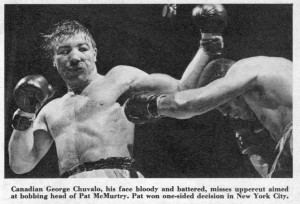 Watching the tape, I was blown away by McMurtry in his New York debut. I realize this was a pre-prime Chuvalo, but the Tacoma invader was simply outstanding. If you want to see the definition of a boxer/puncher on film, watch this bout. After a cautious start, Pat was rocked by a series of left hooks from the Canadian in the second round. Seizing his advantage, George swarmed all over his opponent but failed to put him away before rounds end. After that it was all McMurtry, as he seemed to step up the pressure in each ensuing round. Drilling the Northern invader with jarring left jabs and crushing uppercuts, he soon had Chuvalo backing up instead of crowding him. The Canadian started breathing hard with his mouth open, coughing periodically as the blood from his bloody nose hindered his breathing. By fights end, the prefight favorite was bleeding over both eyes with the left one closing fast, in addition to a bloody nose. George’s 19 pound weight advantage appeared to have no effect on the Tacoma lad. This might have been the best performance of McMurtry’s career. Apparently Ring magazine thought so, as they put Pat back in their top ten rankings.
Watching the tape, I was blown away by McMurtry in his New York debut. I realize this was a pre-prime Chuvalo, but the Tacoma invader was simply outstanding. If you want to see the definition of a boxer/puncher on film, watch this bout. After a cautious start, Pat was rocked by a series of left hooks from the Canadian in the second round. Seizing his advantage, George swarmed all over his opponent but failed to put him away before rounds end. After that it was all McMurtry, as he seemed to step up the pressure in each ensuing round. Drilling the Northern invader with jarring left jabs and crushing uppercuts, he soon had Chuvalo backing up instead of crowding him. The Canadian started breathing hard with his mouth open, coughing periodically as the blood from his bloody nose hindered his breathing. By fights end, the prefight favorite was bleeding over both eyes with the left one closing fast, in addition to a bloody nose. George’s 19 pound weight advantage appeared to have no effect on the Tacoma lad. This might have been the best performance of McMurtry’s career. Apparently Ring magazine thought so, as they put Pat back in their top ten rankings.
Commenting on his trip to New York, Pat said; “I entered Jack Dempsey’s restaurant and was greeted by the Manassa Mauler himself. After complementing me on my career he introduced me to a friend sitting at his table. When the stranger stood, he was huge. Dempsey’s massive friend turned out to be the Pottawatomie giant, former heavyweight champ, Jess Willard. Apparently these former rivals from forty years past had become pals.”
Two months later, McMurtry was back in the Garden to face Cuban giant, Nino Valdes. As successful as the Tacoma import had been to date, typically he was a slow starter. It proved to be his downfall against Valdes. Spotting his opponent 25 pounds, Pat was overwhelmed by the Cuban’s devastating attack. Valdes dropped McMurtry with a left hook to the head near the midway mark of the opening round. He floored him again with a right hand, following two left hooks. As Nino swarmed over his man, McMurtry dropped to one knee, bounced up and reeled against the ropes as Referee Harry Kessler stopped it. Under New York rules, it was mandatory to stop a fight after three knockdowns in the same round.
As with the other setbacks in his career, McMurtry responded in the only way he knew, start another win streak. Returning to the northwest, Pat won a decision over seasoned pro Garvin Sawyer in Portland. In July he returned to Seattle, scoring a knockout over Earl Atley in three. Returning to Seattle three months later, he was matched with old rival, Bob Albright. Over the first four rounds, Pat was content to counter punch letting Albright force the action. In the fifth, McMurtry landed a tremendous overhand right to the Californian’s nose. Following up with a barrage of left jabs that quickly had the blood flowing. Between rounds, the ring physician determined Albright’s nose was broken and the fight was stopped.
Two weeks after the Albright bout, Pat returned to Portland for what would be his final fight. His opponent was Eddie Machen, whose only pro loss was a stunning upset to Ingemar Johansson the previous year in Gothenburg, Sweden. As for the fight itself, it was a replay of the Valdes fight, with Machen playing the role of the Cuban. The opening minute of the scheduled twelve rounder was a feeling out process, with both fighters throwing a few left jabs. Suddenly Machen caught McMurtry flush on the jaw with a left hook, as Pat toppled over Eddie hit him again. The Tacoma lad took a nine count and got up. Machen rushed in and put him down once more with another left hook and a straight right. When McMurtry got up he appeared unaware of where he was. A left and right from Machen and he was down again. Referee Ralph Gruman spread his arms over McMurtry, as the fighter struggled to get up. The fight was over at 2:11 of the first round.
Neurological exams after the Machen bout showed that McMurtry had suffered permanent brain damage, which would affect his balance for life. Ranked as high as #5 by Ring Magazine, Pat had to hang up his gloves for good. Upon retirement Pat sold appliances for Sears and drove a truck for the Pierce County road department. Always good at managing his money, Pat has lived well in retirement. Pat and his late wife Phyllis produced two beautiful children; Shannon and Patrick.
Pat did have one unscheduled comeback 10 years ago in a Tacoma supermarket. Pushing his cart, Pat accidently collided with another shopper. The much younger man was dressed like a dime store cowboy in jeans, denim jacket and cowboy boots. The Roy Rogers lookalike started chiding Pat for failing to watch where he was going. Pat apologized and continued down the aisle looking for tomato sauce. Pat started mumbling to himself, as he looked at the selections. The wrangler asked; “why are you talking to yourself? You belong in a home.” Pat responded “you should tie you shoes.” When cowboy Bob looked at his boots, “I hit him with a terrific left hook. The fool went sprawling into the shelves of tomato paste. I left him on the floor with broken jars of oregano sauce dripping on his cowboy costume.” Checking out at the cash register, the clerk asked Pat if he had seen the man who had been taken out to the store in a stretcher. Pat responded; “no I guessed I missed all the excitement.” I read about the mysterious assault in the Seattle Post-Intelligencer.
When I drove to Tacoma to conduct the interview I found out Pat was in the local hospital with a broken arm suffered in a fall. Calling ahead I asked Pat if I could bring him anything, as most hospital food will never be confused with quality dining. “If you could bring me a pint of Jamison Irish whiskey it would be appreciated.” I got caught at the nurses’ station, smuggling in Pat’s favorite relaxant in a brown paper bag. Taking the bottle, the nurse assured me that Pat would be rationed two shots a day.
Although Pat might have slowed down physically, there’s nothing wrong with his mind. Grabbing the tape recorder from my hand, the Tacoma Tiger spoke clearly about his life for two hours; making it the easiest interview I ever had. The Pacific Northwest is a close net boxing community, and Pat has friends, Boone Kirkman, Larry Buck and Leo Randolph checking up on him regularly. If they bring their shot glasses, maybe he’ll offer them a taste of Jamison to tide them over till St. Patrick’s Day.
Postscript: Pat McCurtry died April 17, 2011, after a battle with liver cancer, aged 79.
